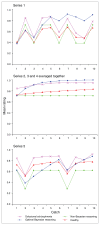The contribution of hypersalience to the "jumping to conclusions" bias associated with delusions in schizophrenia
- PMID: 20040242
- PMCID: PMC2799500
- DOI: 10.1503/jpn.090025
The contribution of hypersalience to the "jumping to conclusions" bias associated with delusions in schizophrenia
Abstract
Background: Previous schizophrenia research involving the "beads task" has suggested an association between delusions and 2 reasoning biases: (1) "jumping to conclusions" (JTC), whereby early, resolute decisions are formed on the basis of little evidence and (2) over-adjustment of probability estimates following a single instance of disconfirmatory evidence. In the current study, we used a novel JTC-style paradigm to provide new information about a cognitive operation common to these 2 reasoning biases.
Methods: Using a task that required participants to rate the likelihood that a fisherman was catching a series of black or white fish from Lake A and not Lake B, and vice versa, we compared the responses of 4 groups (healthy, bipolar, nondelusional schizophrenia and delusional schizophrenia) when we manipulated 2 elements of the Bayesian formula: incoming data and prior odds.
Results: Regardless of our manipulations of the Bayesian formula, the delusional schizophrenia group gave significantly higher likelihood ratings for the lake that best matched the colour of the presented fish, but the ratings for the nonmatching lake did not differ from the other groups.
Limitations: The limitations of this study include a small sample size for the group of severely delusional patients and a preponderance of men in the schizophrenia sample.
Conclusion: Delusions in schizophrenia are associated with hypersalience of evidence-hypothesis matches but normal salience of nonmatches. When the colour of the incoming data is uniform (fish of only one colour), this manifests as JTC early in a series, and when the colour of incoming data varies (both black and white fish), this manifests as an overadjustment midseries. This account can provide a unifying explanation for delusion-associated performance patterns previously observed in the beads task in schizophrenia.
Figures






Similar articles
-
Unstable Belief Formation and Slowed Decision-making: Evidence That the Jumping-to-Conclusions Bias in Schizophrenia Is Not Linked to Impulsive Decision-making.Schizophr Bull. 2022 Mar 1;48(2):347-358. doi: 10.1093/schbul/sbab108. Schizophr Bull. 2022. PMID: 34554260 Free PMC article.
-
Examining reasoning biases in schizophrenia using a modified "Jumping to Conclusions" probabilistic reasoning task.Psychiatry Res. 2018 Dec;270:180-186. doi: 10.1016/j.psychres.2018.09.020. Epub 2018 Sep 18. Psychiatry Res. 2018. PMID: 30261407
-
Over-adjustment or miscomprehension? A re-examination of the jumping to conclusions bias.Aust N Z J Psychiatry. 2012 Jun;46(6):532-40. doi: 10.1177/0004867411435291. Epub 2012 Jan 5. Aust N Z J Psychiatry. 2012. PMID: 22679205
-
Dopamine, cognitive biases and assessment of certainty: A neurocognitive model of delusions.Clin Psychol Rev. 2017 Jun;54:96-106. doi: 10.1016/j.cpr.2017.04.006. Epub 2017 Apr 18. Clin Psychol Rev. 2017. PMID: 28448827 Review.
-
[Etiopathogeny of the delusion of pregnancy using a literature review: Role of hyperprolactinemia and application of the theory of abductive inference].Encephale. 2014 Apr;40(2):154-9. doi: 10.1016/j.encep.2013.04.008. Epub 2013 Jul 4. Encephale. 2014. PMID: 23830681 Review. French.
Cited by
-
Increased structural connectivity of the medial forebrain bundle in schizophrenia spectrum disorders is associated with delusions of paranoid threat and grandiosity.Neuroimage Clin. 2019;24:102044. doi: 10.1016/j.nicl.2019.102044. Epub 2019 Oct 18. Neuroimage Clin. 2019. PMID: 31678911 Free PMC article.
-
Thinking biases and their role in persecutory delusions: A systematic review.Early Interv Psychiatry. 2022 Dec;16(12):1278-1296. doi: 10.1111/eip.13292. Epub 2022 Apr 9. Early Interv Psychiatry. 2022. PMID: 35396904 Free PMC article.
-
Acquisition of visual priors and induced hallucinations in chronic schizophrenia.Brain. 2019 Aug 1;142(8):2523-2537. doi: 10.1093/brain/awz171. Brain. 2019. PMID: 31257444 Free PMC article.
-
The effect of state anxiety on paranoid ideation and jumping to conclusions. An experimental investigation.Schizophr Bull. 2010 Nov;36(6):1140-8. doi: 10.1093/schbul/sbp029. Epub 2009 May 8. Schizophr Bull. 2010. PMID: 19429844 Free PMC article. Clinical Trial.
-
Alternation between different types of evidence attenuates judgments of severity.PLoS One. 2017 Jul 6;12(7):e0180585. doi: 10.1371/journal.pone.0180585. eCollection 2017. PLoS One. 2017. PMID: 28683151 Free PMC article.
References
-
- Huq SF, Garety PA, Hemsley DR. Probabilistic judgements in deluded and non-deluded subjects. Q J Exp Psychol A. 1988;40:801–12. - PubMed
-
- Garety PA, Hemsley DR, Wessely S. Reasoning in deluded schizophrenic and paranoid patients: Biases in performance on a probabilistic inference task. J Nerv Ment Dis. 1991;179:194–201. - PubMed
-
- Moritz S, Woodward TS. Jumping to conclusions in delusional and non-delusional schizophrenic patients. Br J Clin Psychol. 2005;44:193–207. - PubMed
-
- Hemsley DR, Garety PA. The formation of maintenance of delusions: a Bayesian analysis. Br J Psychiatry. 1986;149:51–6. - PubMed
Publication types
MeSH terms
Grants and funding
LinkOut - more resources
Full Text Sources
Medical
